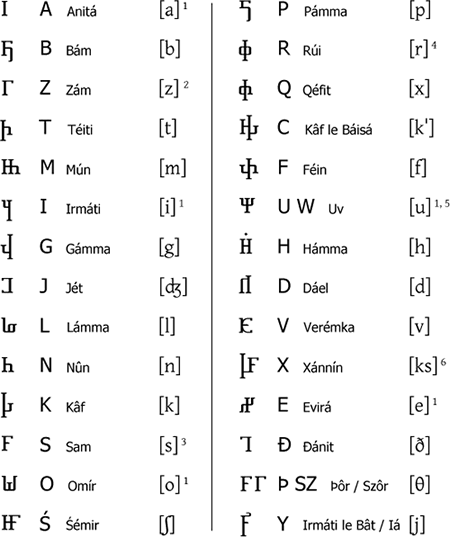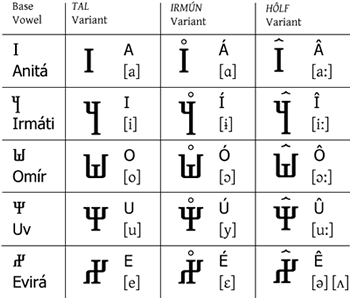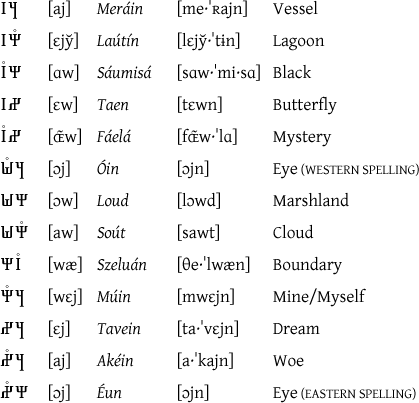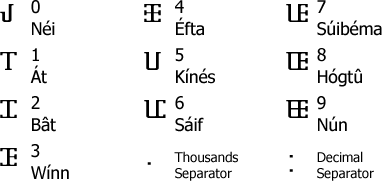Obúka lún Êkimyú

Simon Halfdan Hvilshøj Andersen created Obúka
lún Êkimyú in February 2005 as the precussor
for both the JSEA and the
Atemayar.
Internal history
The Obúka lún Êkimyú (or
the King’s Letters) is the native writing system of the region of
the present city of Ogedemarra in the Aârish State Minustar
on the planet Jeernervaniaa. At that time, that is in the Gregorian
Calendar, in 6000 BC, the Scholars of the Lekinese Court developped
a new alphabet which was more adapted to carving into stone or wood.
They named the alphabet Hêlva lwún Ogémiyú
– which in Lâs translates to Obúka lún
Êlimyú. In the following two millenia, the alphabet
remained the same until the foundation of the kingdom of
Minûstâr in 4550 BC.
In 3970 BC, when Öördj, Queen of Buht and Empress of
Türkfhan, began her Conquest of the Orient Campaigns, the Minustarian
population fled eastward towards the Paký river which marked
the boundary with the newly founded Nobuzyanese Empire. They brought
their alphabet with them and the Obúka had a tremendous
influence on the Nobuzyanese side of the Paký. When Emperor
Fentanvarra the First was crowned Emperor of Nobuzyá he declared
the Obúka as the official alphabet for the Nobuzyanese language
of that time: Gobarrassu. In the present time, it is called Minustarian
Square Alphabet.
Usage
The Obúka can be used to write Lâs,
the Minustarian language, Gobarrassu and Lim, a dialect
of Gobarrassu.
Notable features
- Type of writing system: alphabet
- Direction of writing: written horizontally from the left to the right.
- It has almost no punctuation except a period-like dot (use as
period) and a column-like glyph for all other punctuation. - The five basic vowels of the Obúka exist in three variants
in Lâs: Tal, Irmún and Hôlf, respectively
Flat, Open and Long. Those variants are marked with accents. - Lâs as a set of diphthongs which as very important as not
pronouncing them correctly often leads to misunderstandings.
Obúka lún Êkimyú alphabet
Consonants

- See Vowels and Diphthongs
- Pronounced [Z] if the following vowel is Irmáti
Irmúnisá. - If Sam is followed by B, T, G, K, P, D or X, it is pronounced
[S] and not [s]. - Rúi is not thrilled when it ends a word, unless the
preceding vowel is in its Hôlf variant. - Uv can be used as a vowel or a semi-consonant. When used as a
vowel (or in a diphthong), it can be transcribed with U. If it is
used as semi-consonant, one can use W. For example Núuun
(‘now’) can be transcribed to either Núuun or
Núwun. The latter form is preferred as it clarifies the
pronounciation of the word. - If Xánnín is followed by B, T, G, K, P, D or X, it
is pronounced [kS] and not [ks].
NB: The IPA transliterations in these notes are given in X-SAMPA.
For more details of X-SAMPA see:
www.answers.com/topic/x-sampa
Vowels

Diphthongs

Numerals

The Minustarians tend to group numbers in ten of thousands (by
four digits) while the Nobutzyanese group them by thousands.
Sample text in the Obúka lún Êkimyú alphabet

Transliteration
És’ia iûmám lún bréjáranttu
ferélis el sámsis íkin hóin el rétan.
Gárénta láhéra el s’imrún, élle
íkin bá el gióst hánankennénte.
(Lílúin Átimí ús’ És’iaisá
Iûmánisén Rétányú Táraktan le)
IPA transcription
![]()
Translation
All human beings are born free and equal in dignity and rights. They
are endowed with reason and conscience and should act towards one another
in a spirit of brotherhood.
(Article 1 of the Universal Declaration of Human Rights)
You can download a Obúka lún Êkimyú font
(Minustar Classic) from:
http://www.minustar.net/fonts.html
